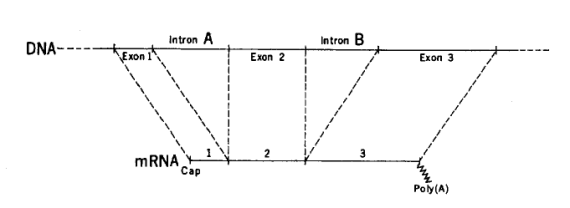Biology students who view a genome for the first time are in for a surprise. Our genes do not seem to be an orderly set of instructions explaining from A to Z how our body’s building blocks are created. Instead, they are ‘spliced’ with fragments of useful information alternating with pieces of ‘gibberish’ known as ‘introns’. Like an Ikea bed assembly manual with pages full of random letters. Biologists were bewildered by this discovery in 1977. Neverteless, they were quick to realize the value of the nonsensical fragments. Introns enable more instructions – and therefore more building blocks – to be produced from one gene. Once a gene is written off, the introns are being cut out by the cell and the ‘real’ information pasted together. The cell sometimes leaves out fragments of information or chooses an alternative ending. In this way, one single manual does not only help to make a normal Ikea bed, but also double dekker beds and sofa beds. More than thirty years later, the origins of introns still remain a mystery. The human genome is full of them, but biologists can only observe their disappearance. Gains of new specimens hardly seem to take place at all. Scientists therefore believe that all introns in the genome are present at the creation of the first multicellular life forms, such as plants and animals. Researchers Ate van der Burgt and Jérome Collemare at Phytopathology have come up with a theory for the origin of introns. They show that new introns have been created in several related species of fungi recently, i.e. in the last ten thousand years. The source is a piece of mobile DNA which can multiply and ‘jump about’ in the genome. This fragment of introner-like element (ILE) shows all the characteristics of introns and ‘jumps’ in the genes of fungi such as Cladosporium fulvum. The researchers published their findings in Current biology on 31 May. They stumbled upon ILEs when Van der Burgt discovered introns which greatly resemble one another. ‘That was unexpected,’ says Collemare. ‘Usually, nothing more than a couple of genetic letters are preserved. You can’t even predict where introns are located.’ A comparison with the genome of fourteen other fungi confirmed that the introns were new. Although disappearances do occur, it is very unlikely that thirteen fungi have lost exactly the same intron. Both the researchers eagerly speculate that their mechanism works in more organisms than only fungi. ‘These elements appeared perhaps also in the ancestor of all multicellular organisms,’ says Van der Burgh. For the time being, the results raise more questions than provide answers. The researchers first want to find out exactly how ILE works.
How ‘gibberish’ got into our genes
The handbook on life also contains - besides useful information - 'gibberish'. For thirty years, biologists have been questioning how such nonsense found its way into our genes. Two Wageningen phytopathologists have now come up with a new theory.

